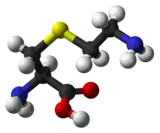 | |
 | |
| Names | |
|---|---|
| IUPAC name
S-(2-Aminoethyl)-L-cysteine | |
| Systematic IUPAC name
(2R)-2-Amino-3-[(2-aminoethyl)sulfanyl]propanoic acid | |
| Other names
Thialysine; L-3-[(2-Aminoethyl)thio]alanine; L-4-Thialysine; Thiosine | |
| Identifiers | |
3D model (JSmol) |
|
| ChEBI | |
| ChEMBL | |
| ChemSpider | |
PubChem CID |
|
| UNII | |
CompTox Dashboard (EPA) |
|
| |
| |
| Properties | |
| C5H12N2O2S | |
| Molar mass | 164.22 g·mol−1 |
Except where otherwise noted, data are given for materials in their standard state (at 25 °C [77 °F], 100 kPa).
Infobox references | |
S-Aminoethyl-l-cysteine, also known as thialysine, is a toxic analog of the amino acid lysine in which the second carbon of the amino acid's R-group (side chain) has been replaced with a sulfur atom.
Strictly speaking, L-thialysine is actually considered an S-(2-aminoethyl) analogue of L-cysteine. This compound is known to have cytotoxic affects as it inhibits protein synthesis and lysine 2,3-aminomutase.[1]
References
- ↑ "S-(2-Aminoethyl)-L-cysteine". pubchem.ncbi.nlm.nih.gov. Retrieved 5 February 2023.
External links
- H-Cys(aminoethyl)-OH·HCl at ChemImpex
- Thialysine at US Biological
This article is issued from Wikipedia. The text is licensed under Creative Commons - Attribution - Sharealike. Additional terms may apply for the media files.